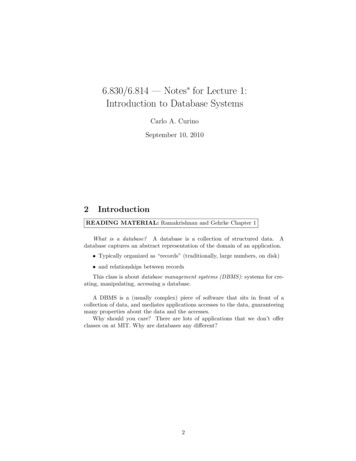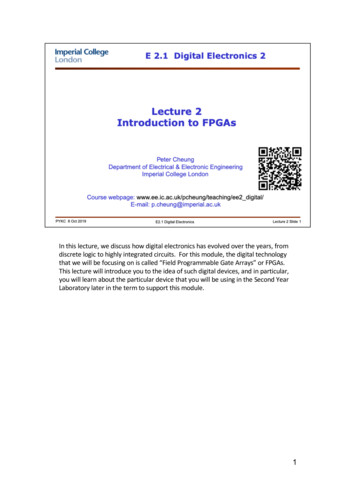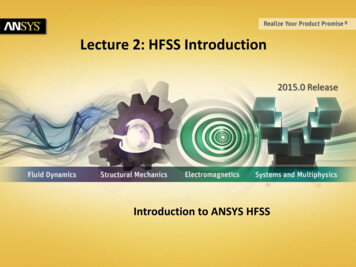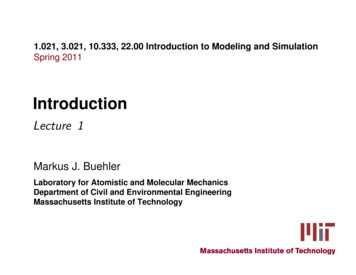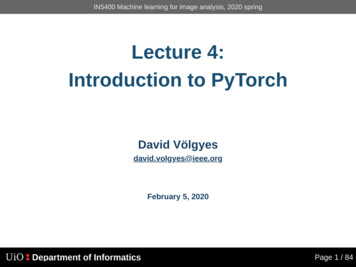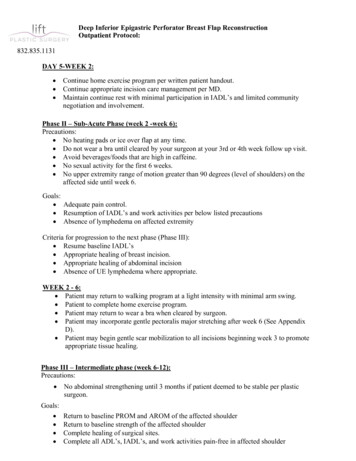
Transcription
Lecture 1: Introduction to Deep LearningCSE599W: Spring 2018
Lecturers
ML Applications need more than algorithmsLearning Systems: this course
What’s this course Not about Learning aspect of Deep Learning (except for the first two) System aspect of deep learning: faster training, efficient serving, lowermemory consumption.
Logistics Location/Date: Tue/Thu 11:30 am - 12:50pm MUE 153 Join slack: https://uw-cse.slack.com dlsys channel We may use other time and locations for invited speakers. Compute Resources: AWS Education, instruction sent via email. Office hour by appointment
Homeworks and Projects Two code assignments Group project Two to three person teamPoster presentation and write-up
A Crash Course on Deep Learning
Elements of Machine LearningModelObjectiveTraining
What’s Special About Deep ositionalModelEnd to End Training
Ingredients in Deep Learning Model and architecture Objective function, training techniques Which feedback should we use to guide the algorithm? Supervised, RL, adversarial training. Regularization, initialization (coupled with modeling) Dropout, Xavier Get enough amount of data
Major ArchitecturesImage ModelingConvolutional NetsLanguage/SpeechRecurrent Nets
Image Modeling and Convolutional Nets
Breakthrough of Image Classification
Evolution of ConvNets LeNet (LeCun, 1998)– Basic structures: convolution, max-pooling, softmax Alexnet (Krizhevsky et.al 2012)– ReLU, Dropout GoogLeNet (Szegedy et.al. 2014)– Multi-independent pass way (Sparse weight matrix) Inception BN (Ioffe et.al 2015)– Batch normalization Residual net (He et.al 2015)– Residual pass way
Fully Connected LayerOutputInput
Convolution Spatial Locality SharingSpatial LocalityWithout SharingWith Sharing
Convolution with Multiple ChannelsSource: http://cs231n.github.io/convolutional-networks/
Pooling LayerCan be replaced by strided convolutionSource: http://cs231n.github.io/convolutional-networks/
LeNet (LeCun 1998) Convolution Pooling Flatten Fully connected Softmax output
AlexNet (Krizhevsky et.al 2012)
Challenges: From LeNet to AlexNet Need much more data: ImageNetA lot more computation burdens: GPU Overfitting prevention Dropout regularizationStable initialization and training Explosive/vanishing gradient problemsRequires careful tuning of initialization and data normalization
ReLU Unit ReLU Why ReLU?– Cheap to compute– It is roughly linear.
Dropout Regularization Randomly zero out neurons withprobability 0.5 During prediction, use expectationvalue (keep all neurons but scaleoutput by 0.5)Dropout Mask
Dropout Regularization Randomly zero out neurons withprobability 0.5 During prediction, use expectationvalue (keep all neurons but scaleoutput by 0.5)Dropout Mask
GoogleNet: Multiple Pathways, Less Parameters
Vanishing and Explosive Value Problem Imagine each layer multipliesIts input by same weight matrix W 1: exponential explosionW 1: exponential vanishingIn ConvNets, the weight are not tied, buttheir magnitude matters Deep nets training was initialization sensitive
Batch Normalization: Stabilize the Magnitude Subtract mean Divide by standard deviation Output is invariant to input scale!– Scale input by a constant– Output of BN remains the same Impact– Easy to tune learning rate– Less sensitive initialization(Ioffe et.al 2015)
The Scale Normalization (Assumes zero mean)ScaleNormalizationInvariance toMagnitude!
Residual Net (He et.al 2015) Instead of doing transformationadd transformation result to input Partly solve vanishing/explosivevalue problem
Evolution of ConvNets LeNet (LeCun, 1998)– Basic structures: convolution, max-pooling, softmax Alexnet (Krizhevsky et.al 2012)– ReLU, Dropout GoogLeNet (Szegedy et.al. 2014)– Multi-independent pass way (Sparse weight matrix) Inception BN (Ioffe et.al 2015)– Batch normalization Residual net (He et.al 2015)– Residual pass way
More Resources Deep learning book (Goodfellow et. al) Stanford CS231n: Convolutional Neural Networks for Visual Recognition http://dlsys.cs.washington.edu/materials
Lab1 on Thursday Walk through how to implement a simple model for digit recognitionusing MXNet GluonFocus is on data I/O, model definition and typical training loopFamiliarize with typical framework APIs for vision tasks Before class: sign up for AWS educate /apply/Create AWS Educate Starter Account to avoid getting chargedWill email out instructions, but very simple to DIY, so do it today!
Ingredients in Deep Learning Model and architecture Objective function, training techniques Which feedback should we use to guide the algorithm? Supervised, RL, adversarial training. Regularization, initialization (coupled




